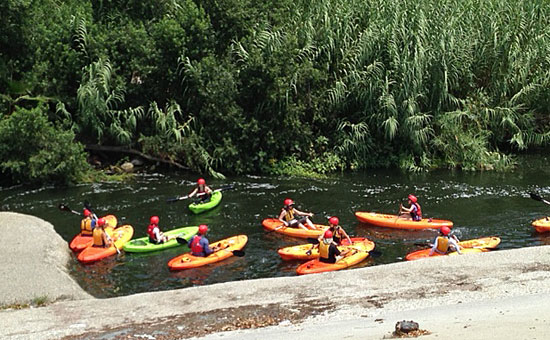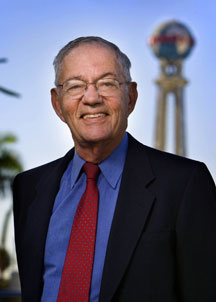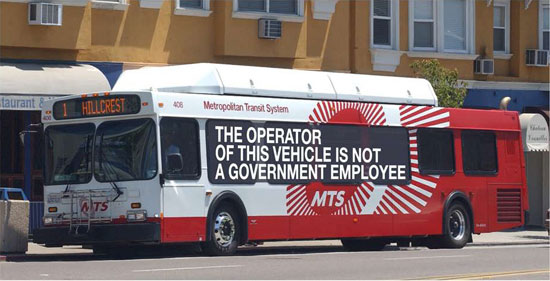Sunset off-ramp to close for 4 months
July 25, 2013
Say so long—for a long time—to the Sunset off-ramp to the northbound 405 Freeway. Starting Aug. 3, the ramp will close for 120 days, adding another level of complication to one of the region’s longest-running construction zones.
The closure will enable construction workers to create a longer, better configured off-ramp as part of the 405 Project, which also includes a 10-mile northbound carpool lane along with other improvements. As it currently stands, the work isn’t expected to be finished until Nov. 30, two days after Thanksgiving. Metro’s list of suggested detours is here.
A big impact of the Sunset ramp closure will be on morning commuters to UCLA. An estimated 800 motorists an hour travel the ramp during the peak morning travel time.
It’s not the only long-term ramp closure scheduled to hit this summer. The eastbound Wilshire Boulevard on-ramp to the northbound 405 will also be closing, for 90 days starting August 22.
“The traffic issues will be in completely different areas,” said Kasey Shuda, construction relations manager for the project, adding that officials will be evaluating how the two closures affect traffic flow and have contingency plans to put in place should they be needed.
Adding to the overall pain, Sepulveda Boulevard—a popular alternative to the 405—also closes most nights for construction work, although it remains open during the daytime.
In the slightly better news department, project officials said they’ve installed 5 new and more visible message signs to make it easier for motorists to see at a glance which ramps are closing ahead for overnight work. Those nightly ramp closures are in addition to the upcoming long-running closures of the Wilshire and Sunset ramps.
Posted 7/25/13
Another hard look at DCFS
July 25, 2013

A blue ribbon panel will investigate the vast network of agencies responsible for keeping children safe.
An independent commission created as Los Angeles County’s latest effort to keep children safer in its sprawling child welfare system took final shape this week, as the Board of Supervisors named the last four appointees, ranging from child advocates to the former head of the county’s juvenile court.
The appointments to the Blue-Ribbon Commission on Child Protection rounded out a 10-member panel established after the May 24 death of Gabriel Fernandez. The 8-year-old Palmdale boy was left by social workers in the care of his mother and her boyfriend despite multiple reports of abuse, neglect and torture.
The mother and boyfriend are being held on murder charges and several employees have been placed on desk duty pending results of an internal investigation at the Department of Children and Family Services.
In the wake of that case and others, however, a majority of the supervisors also believed that that the child protective system needed a deeper examination by an independent investigative body modeled after the Citizen’s Commission on Jail Violence, which last year recommended reforms after disclosures of deputy brutality in the county lockup.
Former DCFS Director David Sanders, appointed by Supervisor Mark Ridley-Thomas, said in an interview that the panel will have a broad mandate to investigate the network of agencies that interact in the child welfare system, including law enforcement and schools.
“This is a full, countywide, responsibility and not just a DCFS responsibility,” Sanders stressed in an interview. “What’s most critical is to understand very specifically how many children are being seriously injured due to abuse and neglect. What are the numbers of fatalities? How many children are being re-injured after they come to the attention of the agency? And how can the county improve safety for children?”
Retired Judge Terry Friedman, appointed by Supervisor Zev Yaroslavsky, said the panel will need to distinguish itself from earlier investigations that have led to management shakeups and hundreds of recommended reforms.
“It’s something we need to address—are we different or are we just the next installment of a longstanding litany of good-intended efforts?” Friedman said. “And if not, how do we approach this issue differently?”
One challenge the commission will face, he added, is the belief that, with the right set of solutions, child deaths can be halted altogether in a system as big and complex as Los Angeles County’s.
“That isn’t to say we can’t make it less likely,” said Friedman, whose 15 years on the bench included stints as the supervising judge for the juvenile dependency court and presiding judge for the juvenile court.
“But realistically, the challenges are so embedded in our society that the best one can hope for is to recognize possibilities and limitations and be realistic in order to make some progress, rather than pretending that perfection is possible.”
Friedman was named to the panel on Tuesday, along with Leslie Gilbert-Lurie, a founding board member and past chair of the Alliance for Children’s Rights and a former member of the Los Angeles County Board of Education, and Janet Teague, who has served both on the Alliance board and on the Los Angeles County Commission for Children and Families. Also appointed this week was Gabriella Holt, a former member of the Los Angeles County Board of Education and a current member of the Los Angeles County Probation Commission.
Like Friedman, Gilbert-Lurie was appointed by Yaroslavsky. Supervisor Don Knabe appointed Holt and Teague.
The four completed a series of earlier appointments that included:
- Marilyn Flynn, dean of the USC School of Social Work, appointed by Ridley-Thomas.
- Richard Martinez, a former foster youth who is superintendent of the Pomona Unified School District, and Andrea Rich, former president of the Los Angeles County Museum of Art, both appointed by Supervisor Gloria Molina.
- Dan Scott, a recently retired veteran of the Sheriff’s Department’s Special Victim’s Bureau, and DickranTevrizian, a retired U.S. District Court judge, both appointed by Supervisor Michael D. Antonovich.
Among the more intriguing picks was Sanders, who oversaw DCFS from 2003 until 2006. Now based in Seattle, he left to become executive vice president of systems improvement for a national foundation specializing in foster care, the Casey Family Programs.
Since his departure, the department has had five directors and acting directors, with the latest turnover occurring last year, when veteran county executive Philip Browning agreed to take over. Browning—who had overhauled the county’s child support efforts and the Department of Public Social Services—was implementing a new strategic plan and training curriculum at DCFS when the Fernandez death was disclosed.
“It’s a tough job,” Sanders said, adding that he hopes the commission will focus on the big child protective picture “rather than interfere or kind of rehash issues that have been examined multiple times.”
“The demands on the department can be quite daunting,” he added. “But I think Phil is somebody who has a lot of experience in the county, and I hope the commission can augment his work and take some of the pressure off him for issues that are really countywide.”
Posted 7/25/13
A new river runs through it
July 25, 2013
For most longtime Angelenos, the Los Angeles River has represented little more than a concrete scar across the county, a channel sending urban runoff and debris towards the sea. Although largely justified in the past, that perception has failed to keep pace with the river’s emerging new realities and its potential to become one of the grandest urban greenways in America.
There was a time when the Los Angeles River was a lifeline for our region. Along its banks, the Gabrielino Indians hunted, fished and lived. The Spanish established the city’s earliest settlements on the river, which would later power the area’s industrial growth. But by the early 20th Century, the river simply could no longer co-exist with the Los Angeles Basin’s explosive growth. A deadly flood in the winter of 1938 finally led to its encasement in concrete, paving the way for the river to become more famous as a backdrop for movie car chases than for its real-life story.
To be sure, long stretches of the river’s 51-miles remain as barren today as they did a quarter-century ago. But elsewhere, a rebirth has been taking root like the lush foliage that again blankets the riverbed between downtown L.A. and Griffith Park. In fact, through a burgeoning public-private partnership, a reimagining of the river’s place in modern-day Los Angeles is gaining unprecedented traction.
President Obama recently made the rejuvenation of the L.A. River a top priority in his urban waterways initiative. And with the federal government’s earlier recognition that the river should be open for recreational use, higher water quality standards are also on the way.
The City of Los Angeles, along with the county and other municipalities, has built miles of new bikeways along the river. In April, NBCUniversal committed nearly $14 million toward the completion of a 6.4 mile gap between Griffith Park and Studio City. Pocket parks also are sprouting on the river’s banks. A summer pilot program has people from across the region kayaking and fishing in its Glendale Narrows passage. And this week, we celebrated the public and private support that will soon give rise to La Kretz Crossing—a stunning pedestrian, equestrian and cyclist bridge near Atwater Village.
But all this is only a start in turning the river into a truly vibrant public space, where our diverse population can not only share recreational opportunities but also forge a broader sense of community from the valley to the ocean. In one of the nation’s most densely developed regions, the Los Angeles River represents a unique opportunity to transform blighted infrastructure into a scenic refuge—a quintessentially L.A. version of New York’s hugely popular “High Line,” a mile-long aerial park built along old railroad tracks.
That’s the charge of Greenway 2020, an initiative spearheaded by the non-profit Los Angeles River Revitalization Corporation, which has an immediate goal of completing all 51 miles of the river bikeway by the end of this decade. Filling in gaps totaling 24 miles through government and private financing, the path would extend from the west San Fernando Valley to Long Beach, complete with amenities such as bike shops, eateries and picnic sites.
Daily commuters would be able to ditch crowded roads and buses in favor of a beautiful—and healthy—bike to work. The 100,000-plus cyclists who’ve turned out for the street-closing CicLAvia events is proof of the pent-up demand for bicycle experiences that don’t compete with automobiles. Entire families, meanwhile, would have a desperately needed getaway in our concrete landscape to play, to breathe and to build memories.
Every world-class city has public spaces that define it. But these monuments to urban life don’t build themselves. Communities come together to create them, and such will be the case for Greenway 2020. It will require coordination and commitment among L.A.’s community leaders, its governmental agencies and its private sector, including business and property owners along the river.
Most of all, it will require a grassroots movement to prove that Los Angeles is ready to make this vision a reality. We urge you to get involved – sign up at larivercorp.com to join Greenway 2020’s effortsand learn more about the project. Attend community meetings. Convey your support to your elected officials. Participate in L.A. River cleanups. Bike and kayak with your friends.
And help us chart a course for the river that will, once again, let it nourish life across Los Angeles.
This piece was co-authored by Allan J. Abshez, board member of the Los Angeles River Revitilizaton Corp.
Posted 7/25/13
Bridging the equine divide
July 25, 2013
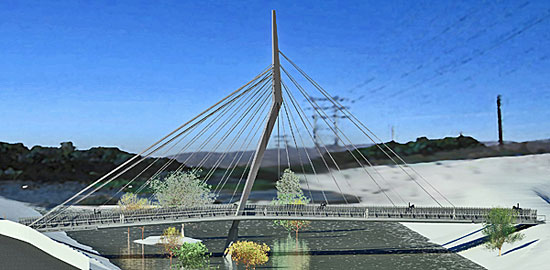
La Kretz Crossing will represent a gateway for equestrians and a symbol of the L.A. River's restoration.
The Los Angeles River, it seems, is no place for horseplay.
For some two decades, equestrian advocates have pushed for a bridge over the river to connect the stables of Atwater Village to the trails of Griffith Park. The only alternative has been to ford the shallow river, a bit of tricky navigation even for skilled riders because of the slick, algae-covered rocks beneath the surface.
“The horses look like they’re on roller skates, their legs going in all directions,” says longtime rider Lynn Brown, a member of the City of Los Angeles’ Equine Advisory Committee. “Almost no one who keeps horses on the Atwater side crosses the river. It’s so dangerous.”
But that’s about to change. Real estate developer and philanthropist Morton La Kretz has ridden to the rescue, donating nearly $5 million for a strikingly-designed bridge that will allow equestrians, pedestrians and cyclists to cross the water north of Los Feliz Boulevard. Maybe just as important, officials say, the 300-foot-long La Kretz Crossing—with a towering support structure visible from the adjacent 1-5 Freeway—will signal to broader L.A. that the river’s renaissance is for real.
The construction of the bridge, scheduled for completion by the end of next year, is being overseen by the non-profit Los Angeles River Revitalization Corp., created by the City of Los Angeles to bring together public and private donors to transform the river into one of the nation’s premiere urban playgrounds. In fact, as part of the publicity surrounding La Kretz Crossing, the group this week announced the launch of Greenway 2020, an ambitious initiative to finish all 51 miles of the L.A. River bikeway by decade’s end, complete with such amenities as picnic sites, eateries and bike shops.
In addition to La Kretz’ donation, the bridge is being underwritten by contributions from the city and an allocation of more than $300,000 by Los Angeles County Supervisor Zev Yaroslavsky from voter-approved parks and open space funds.
Designed by the structural engineering firm of Buro Happold, the bridge will be divided with pedestrians and cyclists sharing one side and equestrians on the other. There’ll be a rubberized surface so the horses don’t slip and an eye-level fence to keep them from getting startled by passing cyclists. On the river’s western bank, the bridge will intersect with the bikeway, where equestrians and hikers can access Griffith Park’s trails through an existing tunnel under the freeway.
La Kretz was brought into the fold by renowned landscape architect Mia Lehrer, who says she got to know him while doing work for the environmental organization TreePeople; La Kretz’s name adorns the group’s educational Urban Watershed Garden in Coldwater Canyon. Lehrer says the elderly La Kretz, an avid cyclist, knew she was involved with the river’s restoration and said: “Give me something I can get excited about—and it has to be done while I’m still around.”
Soon, Lehrer says she and the river corporation were pitching the idea of a new bridge, the first that would be built in more than two decades and that would symbolically represent “a gateway” for the reimagined river. “He loved it,” says Lehrer, whose firm is the project’s landscape architect.
And La Kretz wasn’t alone in his enthusiasm.
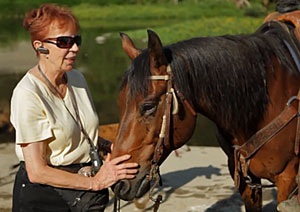
Equestrian advocate Lynn Brown has been pushing for years for a bridge between Atwater Village and Griffith Park.
“When I heard it was going to be built I was like, ‘Yay!” says Javier Del Angel, manager of The Paddock, an upscale, 200-horse stable along the river’s eastern bank in Atwater. He says he and his horse have tumbled twice trying to negotiate the crossing. “It was very scary, and I’ve been riding my entire life.”
Some years back, Del Angel says, a woman hit her head and was in a coma for three months. On another occasion, a horse had to be airlifted out of the river after slipping on the rocks. “His legs just gave out,” Del Angel recalls, adding that a few weeks later, the animal had to be put down.
With La Kretz Crossing providing easy access to the park, Del Angel says he now sees not only safer passage but also new financial opportunities: “I’m thinking about opening a new horse rental business,” he says.
Equestrian advocate Brown also calls plans for the new bridge “a huge deal.” Like Del Angel, she too has stories of river mishaps, including one just last year while helping the L.A. River Revitalization Corp. with a video for its website. The organization said it wanted footage of horses in the river, so Brown recruited the president of the L.A. Equine Advisory Committee, who brought along an extra horse to lead through the water. Before the filming began, she says, the riderless horse stumbled and fell.
Frankly, Brown says, she was “utterly stunned but pleased” that she was even asked to participate in the video in the first place. She said that, for years, the safety and access concerns of the equestrian community seemed to go unheard.
“We thought it was a lost cause,” she says. “I’m happy to be wrong.”
Amid all the hoopla, however, one horseman offered some words of caution.
Tony Lomedico is a lieutenant with the Los Angeles Police Department’s Mounted Unit, which is based along the river in Atwater Village. He acknowledged that the bridge will enhance safety for novice riders but expressed reservations about how some horses might react to being so close to cyclists, calling it a “new sensory experience” to which they’ll have to get accustomed.
“We look forward to the bridge coming,” Lomedico says, but “I think it’s going to create some challenges.”
Posted 7/25/13
Hot home sales fuel record tax roll
July 25, 2013

As home sales boom, at least for now, the county's property tax roll is hitting new heights. Photo/L.A. Times
As Los Angeles’ housing market recovery moves from anemic to heated, county coffers are reaping the benefits of a record-setting, nearly $1.130 trillion property tax roll—more than $50 billion bigger than last year’s.
But thousands of homeowners whose taxes went down when the assessed value of their properties plunged during the recession are catching an upward wave, too. That means higher tax bills for 196,200 property owners, who’ll be forking over an average of $820 more in property taxes this year.
The rise in values isn’t universal: some 121,800 properties that declined in assessed value are staying at the same level this year, while 50,600 properties are experiencing further reductions.
But overall, the trend is positive, with this year’s 4.66% increase in the county tax rolls representing a marked improvement from the 1.49% and 2.24% increases in the previous two years. The upswing reflects a hot market for real estate in many parts of the county, with once dismal home prices rebounding in a big way.
“Strength in the residential real estate market was the largest single factor for the increase in roll value,” Chief Deputy Assessor Santos Kreimann said in a statement.
Assistant Assessor George Renkei added: “In addition to closing the roll at a new record level, we are proud of the accuracy of this year’s forecast as well as the other substantial improvements that were developed and implemented over the past twelve months.”
Even as “SOLD!” increasingly replaces “Bank-owned” or “Foreclosure” on local real estate signs, there are limits on how much a rising market can help the county’s bottom line. Under Prop. 13, property tax increases are tied to the Consumer Price Index and capped at 2%. Most of the time, it’s an uphill progression that allows the county’s tax roll to grow even when individual home prices are in the doldrums. But it’s a testament to how bad things were during the recession that in 2010, the CPI entered negative territory, posing interesting questions for the Assessor’s Office. It had to determine whether, by the law, property assessments would stay level or reflect the CPI’s dip. After consulting with the state Board of Equalization, the assessor granted a .237% reduction to all the eligible properties in the county. Since then, the adjustments have been in positive territory: less than 1% in 2011, 2% in 2012, and 2% again this year.
Property taxes represent a major part of the county’s budget, and the 4.66% increase that pushed the roll to its highest level ever this year translates to an estimated $180 million more in the county’s general fund.
Such increases are welcome news for the county’s budget—but small potatoes compared to the potential infusion that the county will realize when thousands of properties that haven’t changed hands in decades eventually are sold and their values adjusted to current market levels.
Prop. 13 rolled back property assessments to 1975-76 levels until a property is sold, when the new value is allowed to adjust upward. While the vast majority of L.A. properties have changed hands at least once since 1981, 362,710 of them haven’t, representing 19% of the parcels in the county, according to an analysis by the county’s Chief Executive Office. The “stored value” in those properties represents a potential multimillion dollar infusion for the county’s general fund when they’re sold in the years to come.
Posted 7/25/13
Government for the people
July 24, 2013

The CalFresh mobile unit takes the food assistance program on the road for Government Day on Saturday.
This Saturday, you can come home from the mall with more than just a new pair of jeans.
The Panorama Mall is hosting the Northeast San Fernando Valley’s annual Government Day, sponsored by Supervisor Zev Yaroslavsky, on Saturday, July 27. Representatives from dozens of state, city and county agencies will be on hand to answer questions and provide information about services they provide. Looking to adopt a pet? Find out how from the Department of Animal Care and Control. Want to learn more about food assistance? The CalFresh Mobile Unit will be there to screen and register applicants. The event takes place from 10 a.m. to 2 p.m. throughout the mall, which is located at 8401 Van Nuys Boulevard in Panorama City.
Posted 7/24/13
Bill would spell it out, big time
July 18, 2013
Los Angeles transit and county officials have seen the proposed writing on the bus—and they don’t like it one bit.
A bill now under consideration in the state Assembly would require that signs—huge ones, in some cases—be placed on government vehicles driven by contractors to indicate that they are not government employees.
Michael Turner, the Los Angeles County Metropolitan Transportation Agency’s director of government relations, quipped that the sign amounts to a “scarlet letter” for contract employees.
On Tuesday, the Los Angeles County Board of Supervisors, acting on a motion by Supervisor Michael D. Antonovich, voted to oppose the legislation because of costs associated with installing the new messages. Metro’s Board of Directors will take up the matter at next week’s meeting. The San Diego Metropolitan Transportation System and the California Transit Association, which represents transit providers statewide, have already voiced their opposition as well.
The bill, SB-556, is being sponsored by state Senate Majority Leader Ellen Corbett (D-East Bay). According to a fact sheet from one of the bill’s co-sponsors, the California Labor Federation, the bill represents an attempt to reverse a trend toward increased use of contractors and temporary workers, who do not have the same benefits and protections as staff employees. It also aims to inform the public about who is providing services and who is accountable for them.
But for local officials and Metro, the devil is in the details.
As the bill currently reads, the following messages would be required on contractors’ uniforms and vehicles: “THIS IS NOT A GOVERNMENT EMPLOYEE” and “THE OPERATOR OF THIS VEHICLE IS NOT A GOVERNMENT WORKER.”
The font would have to be as large as the largest font otherwise displayed. Because logos are in large type, in Metro’s case that means the messages would be “as large as bus wrap ads, the ones that have the vehicles almost completely covered,” said Metro’s Turner. He said it would cost $1 million to install the signs, in addition to lost revenue from advertising that would otherwise occupy the space. Metro’s 148 contract buses currently display smaller messages to indicate they are operated by private companies.
Chris Patterson, the political director for the organization California Professional Firefighters, another co-sponsor of the bill, acknowledged that the language may need to be “tweaked.”
“This thing is not in final format by any stretch of the imagination,” said Patterson. “We left it intentionally vague so it can be changed as it goes through the process.”
“That said,” Patterson added, “we do strongly believe the public deserves to know who is showing up at their door and performing vital public services. We don’t see how more transparency would be bad.”
As the bill reads now, however, it would place a burden on transit providers—not just giants like Metro—but also smaller ones like the Topanga Canyon Summer Beach Bus and the Agoura Hills Dial-a-Ride.
“This seems a little overkill,” said Amy Brink, who manages the Agoura Hills service. “We are a small city so we have to contract out a lot of our services. We’re not large enough to have a full transit staff.”
Brink expressed concern that people who use her dial-a-ride—most of whom are seniors or disabled—would be confused by the signs.
“With all the details that are already required, I can’t imagine that they could fit anything more on there,” Brink said.
The bill was passed by the state Senate in May, and is slated for a floor vote by the full Assembly when the legislative body reconvenes from its summer break.
Posted 7/18/13
Free Latin tunes in El Cariso Park
July 18, 2013
Susie Hansen Latin Band will bring its jazzy version of Cuban Charanga, a salsa predecessor, to El Cariso Community Regional Park for a free concert on Saturday, July 20. The 10-piece band will play in the second installment of the park’s Free Summer Concert series, sponsored by Supervisor Zev Yaroslavsky. The show takes place from 6 p.m. to 8 p.m. and is open to all ages. El Cariso Park is located at 13100 Hubbard Street in Sylmar.
Of mental health and guns
July 18, 2013
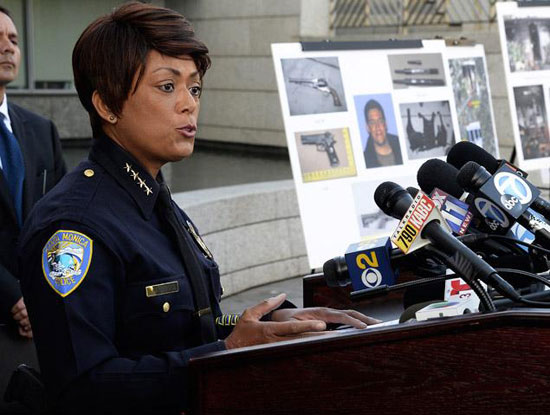
Santa Monica Police Chief Jacqueline Seabrook discusses the shooting rampage of John Zawahri last month.
By now, the scenario is tragically, infuriatingly familiar; a young man with a history of mental illness unleashes a burst of bullets from a high-capacity weapon, stealing lives and shattering communities in a matter of minutes.
The latest rampage erupted last month in Santa Monica. In a span of just 13 minutes, 23-year-old John Zawahri killed five people—including his father and brother—and terrorized countless others on a shooting spree that ended inside the Santa Monica College library, where police gunned him down.
Zawahri was armed with an assault rifle that authorities suspect may have been assembled from parts bought on the Internet, sidestepping California’s ban on such arms. He also was carrying a .44-caliber handgun and more than 1,300 rounds of ammunition. In the days after the shooting, it was disclosed that Zawahri had been admitted to the psychiatric ward of UCLA Medical Center in 2006 after a teacher at his high school discovered the teenager researching assault weapons online.
The Santa Monica slayings have renewed calls for stricter gun and ammunition controls, both of which I’ve long championed while serving on the Board of Supervisors and on the Los Angeles City Council. But the time is well upon us to also confront serious shortcomings in our mental health system—and in the antiquated attitudes too many of us harbor towards treatment—if we’re ever to succeed in curbing the carnage.
Earlier this week, Rep. Henry A. Waxman convened a forum in Santa Monica on “gun violence, mental health and community recovery.” I was honored to have been asked to participate, alongside an impressive panel of federal, state and local representatives. I was especially encouraged by Rep. Waxman’s announcement that he was pursuing legislation that takes aim not only at loopholes in federal gun laws but also at strengthening, in his words, the nation’s mental health infrastructure.
No doubt, the congressman’s efforts to tighten firearms restrictions will, like earlier measures, meet stiff resistance from lawmakers fearful of the National Rifle Assn. and its backers. But what excuse could there be for not embracing Rep. Waxman’s push to improve access to mental health services and to authorize federally-funded research on serious mental illnesses? No matter what our political affiliations or philosophical bents, who among us has not been touched—personally or through family and friends—by mental health problems of varying degrees, including depression and substance abuse?
The truth is that people with mental illnesses are no more violent than anyone else. Studies have shown that only a small fraction of violent crimes are committed by individuals suffering from serious mental illnesses. But when such a person goes untreated and has easy access to weapons designed to inflict maximum damage, the combination can be combustible, as we’ve seen in shootings from Newtown to Santa Monica.
Los Angeles County’s Department of Mental Health is well aware of the stakes and has worked hard to create and adopt best-practice programs aimed at erasing the stigma of mental health treatment and at encouraging those in distress to seek help. Today, county mental health services are delivered in such community settings as school health centers, primary care clinics and senior centers—places where clients come to believe that their mental health is just another facet of their overall health.
The department, moreover, has initiated a number of innovative public education efforts aimed at front-line organizations and individuals who might encounter people experiencing mental health issues. One of those efforts, which began in May, is called “mental health first aid,” a program that’s been gaining traction nationwide. The goal is simple: to teach people how to recognize the symptoms of mental illness in others, how to illicit information from them in a warm and welcoming conversation and how to guide them towards professional help at an early stage.
Trainers for the mental health department—who received their own training from an organization called Mental Health First Aid USA—have so far conducted three sessions, mostly targeting the faith-based community, where individuals might first confide their struggles. But the benefits of the program extend beyond those being “treated.” Each person who undergoes the two-day county training becomes more sensitive themselves to stereotypes and stigmas surrounding mental health issues. In essence, we’re decentralizing traditional mental health models, enabling a broader, more candid discussion of our emotional well-being.
I know these may sound like small steps. But I also know we’re taking them in the right direction. While we can’t undo a tragedy that’s occurred, we can act now in myriad ways to try to prevent those that have yet to happen. And in that cause, it would seem we can all find common ground.
Posted 7/18/13






